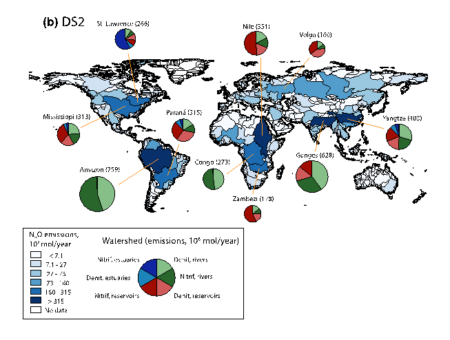
Total N2O emissions (in 106 mol N year−1) from rivers, reservoirs and estuaries combined, for major watersheds worldwide in year 2000, for default scenario 2. Pie charts show the 10 watersheds with the greatest emissions globally, with the size of the chart representing its relative emission flux compared with the other nine watersheds shown (total magnitude of flux shown in brackets after watershed name). The pie charts show the proportion of emissions from denitrification or nitrification in reservoirs, estuaries or rivers
Nitrous oxide is a key greenhouse gas, however, emissions from inland waterways remain a major source of uncertainty in greenhouse gas budgets. The Intergovernmental Panel on Climate Change (IPCC) has proposed emission factors (EFs) of 0.25% and 0.75%, though studies have suggested that both values are either too high or too low. A new approach has been developed for estimating nitrous oxide production, denitrification, and nitrification in water bodies, and water residence time is introduced as a key control on biological activity.
The new approach to modeling nitrous oxide production concludes that the IPCC EFs are likely overestimated by up to an order of magnitude.
Summary
The authors calculated global nitrous oxide (N2O) emissions from rivers, reservoirs and estuaries within a range of 10.6–19.8 Gmol N year-1 (148–277 Gg N year-1). This is more than half, and up to an order of magnitude, lower than most studies based on IPCC’s guidelines. Despite the much-reduced N2O flux estimates, the authors found that anthropogenic perturbations to river systems have doubled to quadrupled N2O emissions from inland waters. They suggest that the IPCC emissions factors of 0.25% and 0.75% are too high to be applied across all rivers, estuaries and reservoirs, and instead they estimate the following ranges of emissions factors: 0.004%–0.005% for rivers, 0.17%–0.44% for reservoirs, and 0.11%–0.37% for estuaries.
The majority of emissions in estuaries and reservoirs originate from nitrification, while denitrification tends to dominate in rivers because of the shorter residence times. Worldwide N2O emissions from inland waters are therefore expected to rise substantially in the coming decades as a result of the ongoing global boom in dam construction, which will nearly double the number of large hydroelectric dams on Earth and increase the water residence within these water bodies.
Citation
Maavara, T., Lauerwald, R., Laruelle, G.G., Akbarzadeh, Z., Bouskill, N.J., Van Cappellen, P., Regnier, P. (2019), Nitrous oxide emissions from inland waters: Are IPCC estimates too high?, Global Change Biology, doi: 10.1111/gcb.14504
